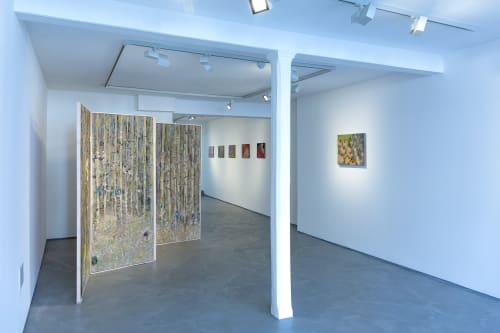Informality is pleased to present Behind Closed Doors, a solo presentation of recent paintings by London-based artist Diane Chappalley.
Can you paint a sunflower? On the surface of things, painting a sunflower might appear to be a simple, straightforward task. But perhaps it is a loaded question, because the implied second part of that question is; can you paint a sunflower after Van Gogh?
For Chappalley, a sunflower can be imagined, autobiographical and art historical all at once. They appear in her paintings from time to time - singular or in clusters - bloated and sun-drunk with dropping heads. Often they are entangled in verdant knots of flora which refer to the landscapes of both the Swiss Alps where she grew up and the hidden green spaces of east London, where she now lives and works.
Conversely, the title Behind Closed Doors alludes to a more private, domestic space - somewhere perhaps unknowable to the viewer. On closer inspection, these pairings cannot easily be described as landscapes in a traditional sense - the spaces described are often dense and feverish; misleading the eye. Using complementary colour to evoke shape and space - Chappalley builds up a visceral surface of course, dry paint - the rough surface of the flax linen providing staunch resistance to the brush. Short, fast strokes accumulate into thickets; smudged and matted undergrowth is depicted with ground-in earthy browns and acidic greens - intensified by spritely flashes of red, yellow and blue suggesting flower heads. And then, all of a sudden, you notice that the sunflowers don’t have stalks - some appear to be floating above the horizon - and in the painting Monte Verita, the sky is wrought in an unnatural, apocalyptic crimson.
Smaller works are painted directly onto gingham linen, recalling themes of the picnic in historical paintings such as Edouard Mandy’s Le Dejeuner sur l’herbe and Claude Monet’s Luncheon on the Grass. The grid-like structure of the material alludes to both domestic and utilitarian ideals - indulging in a kind of rustic fantasy of a tune that neither the viewer nor Chappalley belong to. A personal symbology is at work here, the gingham gives a feeling of nostalgia which is harder to reason with.
This peculiar blending of place and time - weeds from fecund canal verges in Walthamstow, hardy Edelweiss plants that grow up the sides of the Swiss mountains, and the pastoral landscapes of Les Nabis - is a process of distillation, a private conversation that happens alone in the studio of which something remains hidden. The clumps of foliage that often dominate the vistas of Chappalley’s world seek to obscure rather than reveal - the abstract, gestural brushstrokes treading a thin line between representation and decoration.
In the centre of the space stands a paravent - a privacy screen traditionally used for changing behind, but also more commonly as a decorative object - melding ideas of public and private. The four panels show a forest of tree trunks, punctuated by the soft, floating forms of flowers and the dark, bare spines of tree branches. The flowers are in full bloom, while the trees are apparently barren - snowy daubed marks are scattered across the surface eliciting the contradictory times of year. The concertina form of the screen allows for multiple perspectives of the piece - while simultaneously never allowing the work to be viewed in its entirety. Here, Chappalley’s painting exists between states of revealing and hiding; allowing thematic contradictions to easily coexist. These concerns - between indoor and outdoor; hidden and seen - mirror painting’s own conflicting uses as both a decorative, commercial object and a space for intellectual enquiry.

